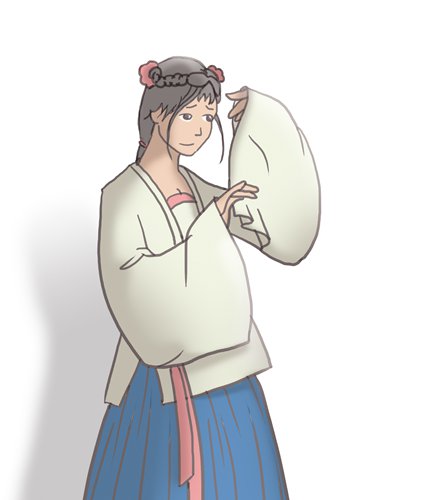METRO SHANGHAI / TWOCENTS
Hanfu revival is not a symbol of China’s nationalism

Illustration: Lu Ting/GT
Hanfu is a traditional robe of the Han people, which has a history of thousands of years in China. In recent years, however, the number of promoters of this ancient attire have grown both online and offline, with annual events promoting hanfu culture taking place around the country.
During traditional Chinese holidays like Mid-Autumn Festival, for instance, hanfu lovers organize activities to wear the clothing while enjoying the full moon together. Hanfu has also become a subculture on Bilibili, a Chinese popular ACG video-sharing platform.
But I have noticed some foreign media disparaging the hanfu revival by calling it "nationalism," which they mean to be a bad thing. For example, an article headlined "A Retro Fashion Statement in 1,000-Year-Old Gowns, With Nationalist Fringe" was published on the Chinese website of the New York Times recently.
I did not feel comfortable reading this article, as it suggested that the hanfu revival is a symbol of China's rising political activism (as opposed to our sincere appreciation of our heritage). The author quoted Kevin Carrico, a lecturer at Macquarie University in Australia, as saying that "most people in the Hanfu movement that I met were nationalists looking for the thrill of wearing traditional clothing."
In my opinion, linking hanfu with politics distracts us from the pure joy we have in learning about traditional Chinese culture. I think the rising popularity of hanfu among the younger generation of Chinese is mainly due to our personal interest in the aesthetics, art and values of ancient China, and has nothing to do with our proud patriotism toward modern China.
I myself started to learn about hanfu about a year ago after seeing pictures of my female friends dressed up in hanfu on their social media. "What are these clothes? From the Tang Dynasty? They look so gorgeous and cool," I commented on a friend's account in 2017. This was my very first reaction toward this unusual apparel, with its delicate and feminine designs and vibrant colors, which, all taken together, enhanced the form and beauty of the wearers.
Likewise, my colleague here at the Global Times, Lanlan, is a die-hard hanfu fan. She said her original intention to join the hanfu community was innocent and had nothing to do with nationalism. "I love hanfu because the traditional clothes are so beautiful and delicate. Buying and wearing hanfu can bring joy to my otherwise boring life," she said.
It is obvious that for many hanfu lovers, learning about and wearing traditional Chinese clothing is a personal hobby and does not have any secret connotations or cult-like symbolism, which some foreign media are suggesting. Not unlike fans of Lego or computers games, we find a simple joy and happiness when playing dress up in our hanfu.
Most hanfu lovers I personally know are not forcing others to accept it. In fact, in most hanfu circles, many are against the idea of linking hanfu with Chinese nationalism.
For example, one netizen on Baidu's online hanfu community wrote that, "I am not Han people, but I am nonetheless deeply attracted by hanfu because these traditional clothes are so beautiful. The key to hanfu promotion is the clothes' aesthetic value, not nationalist ideas."
In short, like kilts to Scottish people and kimono to Japanese, hanfu are a traditional Chinese clothing that we enjoy for their beautiful designs and cultural appreciation. It has absolutely nothing to do with the "nationalism fringe" the New York Times article wrote about. Sadly, many Western media wish to link hanfu with nationalism, and I think this will only hinder people worldwide from discovering the real history and joy of hanfu.
The opinions expressed in this article are the author's own and do not necessarily reflect the views of the Global Times.
